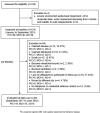Changes in executive function and gait in people with mild cognitive impairment and Alzheimer disease
- PMID: 33907598
- PMCID: PMC8049569
- DOI: 10.1590/1980-57642021dn15-010006
Changes in executive function and gait in people with mild cognitive impairment and Alzheimer disease
Abstract
Changes in executive function and motor aspects can compromise the prognosis of older adults with mild cognitive impairment (MCI) and favor the evolution to dementia.
Objectives: The aim of this study was to investigate the changes in executive function and gait and to determine the association between changes in these variables.
Methods: A 32-month longitudinal study was conducted with 40 volunteers: 19 with preserved cognition (PrC), 15 with MCI and 6 with Alzheimer disease (AD). Executive function and gait speed were assessed using the Frontal Assessment Battery, the Clock-Drawing test and the 10-meter walk test. For data analysis, the Pearson product-moment correlation, two-way repeated-measures ANOVA, and chi-square were conducted.
Results: After 32 months, an improvement in the executive function was found in all groups (p=0.003). At baseline, gait speed was slower in individuals with MCI and AD compared to those with PrC (p=0.044), that was maintained after the follow-up (p=0.001). There was significant increase in number of steps in all groups (p=0.001). No significant association was found between changes in gait speed and executive function.
Conclusions: It should be taken into account that gait deteriorates prior to executive function to plan interventions and health strategies for this population.
Alterações na função executiva e nos aspectos motores podem comprometer o prognóstico de idosos com comprometimento cognitivo leve (CCL) e favorecer a evolução para demência.
Objetivos: O objetivo deste estudo foi investigar alterações na função executiva e na marcha e determinar a associação entre alterações nessas variáveis.
Método: Foi realizado um estudo longitudinal de 32 meses com 40 voluntários: 19 com cognição preservada (PrC), 15 com CCL e 6 com doença de Alzheimer (DA). A função executiva e a velocidade da marcha foram avaliadas por meio de bateria de avaliação frontal, do teste de desenho do relógio e do teste de caminhada de 10 metros. Para a análise de dados, o coeficiente de correlação produto-momento de Pearson, ANOVA de medidas repetidas bidirecional e o qui-quadrado foram realizados.
Resultados: Após 32 meses, houve melhora na função executiva em todos os grupos (p=0,003). No início do estudo, a velocidade da marcha foi mais lenta nos indivíduos com CCL e DA em comparação com os PrC (p=0,044), que foi mantida após o acompanhamento (p=0,001). Houve aumento significativo no número de etapas em todos os grupos (p=0,001). Não foi encontrada associação significativa entre alterações na velocidade da marcha e função executiva.
Conclusões: Deve-se levar em consideração que a marcha se deteriora antes da função executiva para planejar intervenções e estratégias de saúde para essa população.
Keywords: aging; cognition; cognitive dysfunction; longitudinal studies; walking speed.
Conflict of interest statement
Disclosure: The authors report no conflicts of interest.
Similar articles
-
Six-month change in gait speed to discriminate between those with and without falls history in older people with Mild Cognitive Impairment and mild Alzheimer disease.Geriatr Nurs. 2022 Nov-Dec;48:274-279. doi: 10.1016/j.gerinurse.2022.10.002. Epub 2022 Nov 3. Geriatr Nurs. 2022. PMID: 36335854
-
Association Between Gait and Dual Task With Cognitive Domains in Older People With Cognitive Impairment.J Mot Behav. 2018 Jul-Aug;50(4):409-415. doi: 10.1080/00222895.2017.1363702. Epub 2017 Sep 13. J Mot Behav. 2018. PMID: 28901834
-
Limbic and Basal Ganglia Neuroanatomical Correlates of Gait and Executive Function: Older Adults With Mild Cognitive Impairment and Intact Cognition.Am J Phys Med Rehabil. 2018 Apr;97(4):229-235. doi: 10.1097/PHM.0000000000000881. Am J Phys Med Rehabil. 2018. PMID: 29261535 Free PMC article.
-
Motor phenotype of decline in cognitive performance among community-dwellers without dementia: population-based study and meta-analysis.PLoS One. 2014 Jun 9;9(6):e99318. doi: 10.1371/journal.pone.0099318. eCollection 2014. PLoS One. 2014. PMID: 24911155 Free PMC article.
-
The Association Between Gait Speed and Cognitive Status in Community-Dwelling Older People: A Systematic Review and Meta-analysis.J Gerontol A Biol Sci Med Sci. 2019 May 16;74(6):943-948. doi: 10.1093/gerona/gly140. J Gerontol A Biol Sci Med Sci. 2019. PMID: 29917045
Cited by
-
Anticipatory reaching motor behavior characterizes patients within the Alzheimer's disease continuum in a virtual reality environment.Alzheimers Res Ther. 2025 Apr 9;17(1):78. doi: 10.1186/s13195-025-01726-6. Alzheimers Res Ther. 2025. PMID: 40200361 Free PMC article.
-
The Cholinergic Receptor Nicotinic α3 Was Reduced in the Hippocampus of Early Cognitively Impaired Adult Male Mice and Upregulated by Nicotine and Cytisine in HT22 Cells.Cells. 2025 Feb 26;14(5):340. doi: 10.3390/cells14050340. Cells. 2025. PMID: 40072069 Free PMC article.
-
Visual search for real-world scenes in patients with Alzheimer's disease and amnestic mild cognitive impairment.Brain Behav. 2024 Jun;14(6):e3567. doi: 10.1002/brb3.3567. Brain Behav. 2024. PMID: 38841742 Free PMC article.
-
A detection model of cognitive impairment via the integrated gait and eye movement analysis from a large Chinese community cohort.Alzheimers Dement. 2024 Feb;20(2):1089-1101. doi: 10.1002/alz.13517. Epub 2023 Oct 24. Alzheimers Dement. 2024. PMID: 37876113 Free PMC article.
-
Much More Than the Malady: The Promise of a Web-Based Digital Platform Incorporating Self-Report for Research and Clinical Care in Mild Cognitive Impairment.Mayo Clin Proc Digit Health. 2025 May 6;3(2):100224. doi: 10.1016/j.mcpdig.2025.100224. eCollection 2025 Jun. Mayo Clin Proc Digit Health. 2025. PMID: 40502449 Free PMC article. Review.
References
LinkOut - more resources
Full Text Sources
Other Literature Sources


